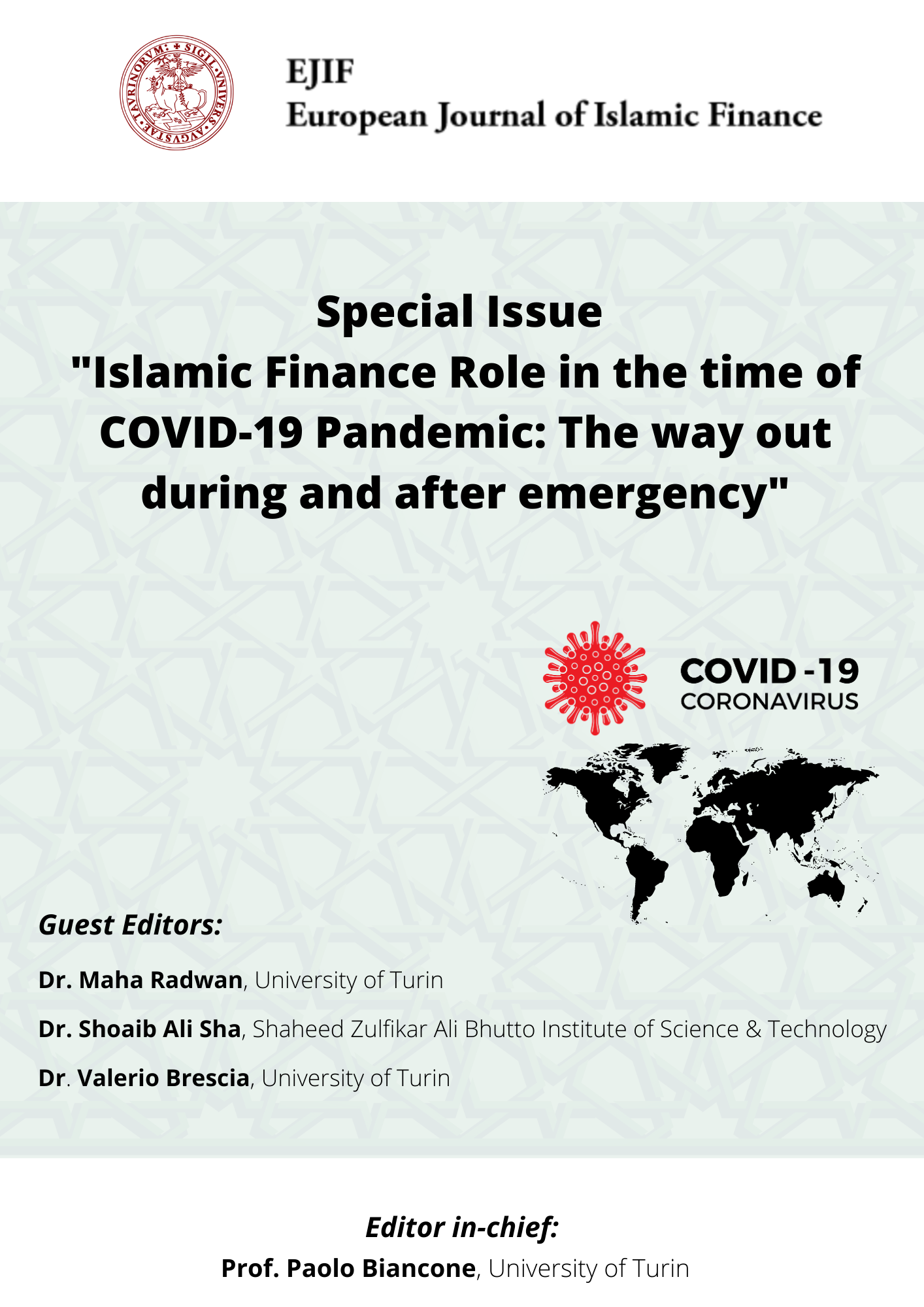Debt Forgiveness and Debt Relief for Covid-19 Economic Recovery Financed through GDP-Linked Sukuk
DOI:
https://doi.org/10.13135/2421-2172/4582Keywords:
debt limits, fiscal space, growth-linked sukuk, sovereign debt management.Abstract
This paper proposes alternatives for governments to deal with the current pandemic crisis today. It suggests ways to deal with the increasing debt levels as a result of the fiscal stimulus issued to cushion the effects of a tremendous shock to the economy.
Firstly, the paper proposes to protect the vulnerable group (based on debt-to-income ratio or its debt-servicing ability) through debt forgiveness and help SMEs through debt relief via debt restructuring for their outstanding loans. To finance this, we propose to convert the increased public debt from these initiatives into equity through a GDP-linked sukuk to stabilise a sovereign’s debt to GDP ratio. The repayment on these sukuk will be in proportion to the country’s GDP whereby the repayment automatically declines when growth is weak and increases when GDP is strong. In doing so, an anticipated deep recession caused by the global pandemic slowdown will makes it less likely to trigger a sovereign debt crisis.
Secondly, such a strategy would provide the issuing government with economic reprieve when growth weakens and tax receipts decline. At the same time, investors can view these sukuk as an alternative asset class through exposure to the real economy, given the low interest rate environment. Both sides are incentivized by the debt-stabilising effects of issuance that would make sovereign defaults less likely and balance risk-taking.
References
Aspen EPIC, Lifting the Weight: Consumer Debt Solutions Framework, November 14, 2018.
D. Barr, O. Bush, and A. Pienkowski. GDP-linked sukuk and Sovereign Default. Bank of England Working Paper No. 484, 2014.
J. Benford, T. Best, and M. Joy, Sovereign GDP-linked sukuk, Bank of England Financial Stability Paper No. 39, 2016, pp. 13.
C. Burnside, and D. Dollar, “Aid, policies, and growth”. American Economic Review, 90 (4), 2000, pp. 847-68.
E. Borensztein, and P. Mauro (2004), “The case for GDP-indexed bond”, Economic Policy, Vol. 19, No. 38, April 2004.
A. Diaw, O. Bacha, and A. Lahsasna, Public Sector Funding and Debt Management: A Case for GDP-linked Sukuk, 8th International Conference on Islamic Economics and Finance, 2011.
EMN-MFC. Microfinance in Europe: Survey Report 2016-2017. December 2018.
European Investment Fund. European Small Business Finance Outlook, December 2019. Working Paper 2019/61. Luxembourg.
A. Ghosh, J. I. Kim, E. G. Mendoza, J. D. Ostry, M. S. Qureshi, Fiscal Fatigue, Fiscal Space and Debt Sustainability in Advanced Economies, NBER Working Paper 16782, 2011.
S. Griffith-Jones, and D. Hertova, GDP-linked Securities, in Bergsten, C. F. and C. R. Henning (eds.), Global Economics in Extraordinary Times; Essays in Honor of John Williamson, PIIE, 2012, Washington DC.
S. Griffith-Jones, and K. Sharma, GDP-indexed sukuk: Making it happen, DESA Working Paper No. 21, 2006.
N. ul Haque, and A. Mirakhor. The Design of Instruments For Government Finance in an Islamic Economy. 1999. MPRA Paper No. 56028, posted 20 May 2014.
J. Huerga, J. Puigvert, and C. Rodriguez, Enhancements on ECB MFI interest rate statistics. in OECD – The Statistics Newsletter. Issue No. 55. March 2012.
ILO, Asia-Pacific Employment and Social Outlook 2018: Advancing Decent Work for Sustainable Development. Bangkok, Thailand.
IMF, Debt: Use it Wisely, IMF Fiscal Monitor. 2016.
M. Joy, GDP-linked Sukuk, Sovereign GDP-Linked Sukuk: Design, Investor Response and Open Issues. Ad Hoc Working Group on The London Term Sheet Discussion Paper, Bank of England, 2017.
J. Kim, and J. Ostry, Boosting Fiscal Space: The Roles of GDP-linked Debt and Longer Maturities, IMF Working Paper Series, No.18/04, 2018.
K. L. McKay, and D. Kingsbury. Student Loan Cancellation: Assessing Strategies to Boost Financial Security and Economic Growth. The Aspen Institute EPIC. April 2019.
J. Mohrenweiser, S. Srikantan, and T. Wan (2017), Insurance-Linked Securities Rating Criteria, Fitch Ratings, 2017, pp. 15
E. Neumayer, Is Good Governance Rewarded? A Cross-National Analysis of Debt Forgiveness. World Development, 30 (6), 2012, pp. 913-30.
J. Ostry, A. Ghosh, J. Kim, and M. Qureshi, Fiscal Space, IMF Staff Position Note, SPN/10/11, 2011, International Monetary Fund, Washington.
A. Pienkowski, Debt Limits and the Structure of Public Debt, IMF Working Paper 44913, 2017.
A. Pienkowski, “Debt limits and the structure of public debt”, Journal of Globalization and Development, Volume 8, Issue 2, 2018, Walter de Gruyter GmbH, Berlin/Boston.
M. Schularick, and A. Taylor, Credit Booms Gone Bust: Monetary Policy, Leverage Cycles, and Financial Crises, 1870-2008, American Economic Review, 2012.
Downloads
Published
How to Cite
Issue
Section
License
EJIF content is licensed under a Creative Commons Attribution 4.0 International License.
Authors keep the copyrights for their work and give the journal the work's first publication copyright, which is at the same time licensed under a Creative Commons License – Attribution, which in turn allows other parties to share the work with an acknowledgement of the work's authorship and initial publication in this journal.


 EJIF has been approved for inclusion in
EJIF has been approved for inclusion in  EJIF has been approved for inclusion in
EJIF has been approved for inclusion in  EJIF is a member of
EJIF is a member of  EJIF is listed in the ANVUR (Italian National Agency for the Evaluation of Universities and Research Institutes) as a scientific journal in both
EJIF is listed in the ANVUR (Italian National Agency for the Evaluation of Universities and Research Institutes) as a scientific journal in both 
